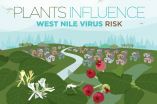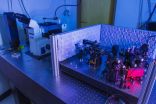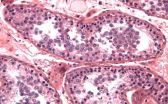(Press-News.org) Boys are more likely than girls to receive a prescription for antipsychotic medication regardless of age, researchers have found. Approximately 1.5 percent of boys ages 10-18 received an antipsychotic prescription in 2010, although the percentage falls by nearly half after age 19. Among antipsychotic users with mental disorder diagnoses, attention deficit hyperactivity disorder (ADHD) was the most common among youth ages 1-18, while depression was the most common diagnosis among young adults ages 19-24 receiving antipsychotics.
Despite concerns over the rising use of antipsychotic drugs to treat young people, little has been known about trends and usage patterns in the United States before this latest research, which was funded by the National Institute of Mental Health (NIMH), part of the National Institutes of Health. Mark Olfson, M.D., M.P.H., of the Department of Psychiatry, College of Physicians and Surgeons and Columbia University and New York State Psychiatric Institute, New York City, and colleagues Marissa King, Ph.D., Yale, New Haven, Connecticut, and Michael Schoenbaum, Ph.D., NIMH, report their findings on July 1 in JAMA Psychiatry.
"No prior study has had the data to look at age patterns in antipsychotic use among children the way we do here," said co-author Michael Schoenbaum, Ph.D., senior advisor for mental health services, epidemiology and economics at NIMH. "What's especially important is the finding that around 1.5 percent of boys aged 10-18 are on antipsychotics, and then this rate abruptly falls by half, as adolescents become young adults."
"Antipsychotics should be prescribed with care," says Schoenbaum. "They can adversely affect both physical and neurological function and some of their adverse effects can persist even after the medication is stopped."
The U.S. Food and Drug Administration (FDA) has approved antipsychotics for children with certain disorders, particularly bipolar disorder, psychosis/schizophrenia, and autism. However, the research team found that the medication use patterns do not match the illness patterns. The mismatch means that many antipsychotic prescriptions for young people may be for off-label purposes, that is, for uses not approved by FDA.
For example, maladaptive aggression is common in ADHD, and clinical trial data suggest that at least one antipsychotic, risperidone, when used with stimulants, can help reduce aggression in ADHD. To date, FDA has not approved the use of any antipsychotic for ADHD, making its use for this diagnosis off-label. In the current study, the combination of peak use of antipsychotics in adolescent boys and the diagnoses associated with prescriptions (often ADHD) suggest that these medications are being used to treat developmentally limited impulsivity and aggression rather than psychosis.
Olfson and colleagues worked with the IMS LifeLink LRx database, which includes 63 percent of outpatient prescriptions filled in the U.S. The team looked at prescription data for 2006-2010 and found antipsychotic use increased with age in both boys and girls, beginning at 0.11 percent in 2010 for ages 1-6 years, increasing to 0.80 percent for ages 7-12 years and increasing again to 1.19 percent for youth ages 13-18 years before dropping substantially to 0.84 percent for ages 19-24.
In children ages 1-6, boys were more than twice as likely as girls to receive an antipsychotic prescription (0.16 vs. 0.06 percent in 2010). This pattern held true for boys and girls ages 7-12 (1.20 vs. 0.44 percent in 2010) before narrowing for the 13-18 age group (1.42 vs. 0.95 percent) and finally becoming more comparable for young men and women ages 19 to 24 (0.88 to 0.81 percent in 2010). Among young people treated with antipsychotics in 2010, the youngest children, ages 1-6, were the least likely to receive the prescription from a psychiatrist (57.9 vs. 71.9, 77.9, and 70.4 percent for the other three age groups). This is a source of concern, as practice guidelines caution practitioners on the use of antipsychotic medications for young children in particular.
Among young people receiving antipsychotic prescriptions, fewer than half had any medical visit that included a mental disorder diagnosis. That may be in part due to stigma about mental illness, or because primary care providers are concerned about reimbursement for treatment related to such diagnoses.
"In addition to having a new look at antipsychotic use among youth, one positive finding coming from this study is that around 75 percent of these kids have at least some contact with a psychiatrist," said NIMH Director Thomas Insel, M.D.
INFORMATION:
Reference:
Olfson, M., King, M., Schoenbaum, M. Treatment of Young People with Antipsychotic Medications in the United States. JAMA Psychiatry. (in press)
About the National Institute of Mental Health (NIMH): The mission of the NIMH is to transform the understanding and treatment of mental illnesses through basic and clinical research, paving the way for prevention, recovery and cure. For more information, visit http://www.nimh.nih.gov.
About the National Institutes of Health (NIH): NIH, the nation's medical research agency, includes 27 Institutes and Centers and is a component of the U.S. Department of Health and Human Services. NIH is the primary federal agency conducting and supporting basic, clinical, and translational medical research, and is investigating the causes, treatments, and cures for both common and rare diseases. For more information about NIH and its programs, visit http://www.nih.gov.
As fireflies are delighting children across the country with their nighttime displays, scientists are closing in on a better understanding of how the insects produce their enchanting glow. They report in the Journal of the American Chemical Society new evidence of how the beetles' chemistry works. Their findings could apply to the bioluminescence of other organisms, too.
About 60 years ago, scientists figured out in broad strokes the cascade of reactions that allows fireflies to produce light. It starts with a chemical called luciferin, which interacts with the energy-transporting ...
CHAMPAIGN, Ill. -- A new study looks at how leaf litter in water influences the abundance of Culex pipiens mosquitoes, which can transmit West Nile virus to humans, domestic animals, birds and other wildlife.
The study found that different species of leaf litter in standing water influence where Culex pipiens mosquitoes deposit their eggs, how quickly the larvae grow, how big they get and whether they survive to adulthood. Because the mosquitoes feed on bacteria that grow on leaf litter, the team also measured how native and non-native leaf species influenced bacterial ...
Living with Type 1 diabetes requires constant monitoring of blood sugar levels and injecting insulin daily. Now scientists are reporting in the ACS journal Industrial & Engineering Chemistry Research the development of an implantable "artificial pancreas" that continuously measures a person's blood sugar, or glucose, level and can automatically release insulin as needed.
Type 1 diabetes, previously known as juvenile diabetes, affects about 1.25 million Americans. About 200,000 of them are under 20 years old. The condition arises when a person's own immune system destroys ...
MOOCs -- massive open online courses -- grant huge numbers of people access to world-class educational resources, but they also suffer high rates of attrition.
To some degree, that's inevitable: Many people who enroll in MOOCs may have no interest in doing homework, but simply plan to listen to video lectures in their spare time.
Others, however, may begin courses with the firm intention of completing them but get derailed by life's other demands. Identifying those people before they drop out and providing them with extra help could make their MOOC participation much ...
The production of petroleum from Canada's oil sands is on the rise with much of it destined for U.S. refineries. As the U.S. takes stock of its greenhouse gas emissions, scientists report in the ACS journal Environmental Science & Technology that the current oil sands production of fuels from "well-to-wheels" releases about 20 percent more carbon dioxide into the atmosphere than making gasoline and diesel from conventional crudes.
In 2013, the oil industry was producing nearly 2 million barrels per day from Canadian oil sands. By 2030, that number is expected to rise ...
JILA researchers have designed a microscope instrument so stable that it can accurately measure the 3D movement of individual molecules over many hours--hundreds of times longer than the current limit measured in seconds.*
The technology was designed to track the machinery of biological cells, down to the tiniest bits of DNA, a single "base pair" of nucleotides among the 3 billion of these chemical units in human genes. But the instrument could be useful well beyond biology, biochemistry and biophysics, perhaps in manufacturing.
JILA is a partnership of the National ...
GRAND RAPIDS, Mich., June 24, 2015 - Researchers at Spectrum Health Helen DeVos Children's Hospital have completed the first clinical trial of a new treatment for children suffering from neuroblastoma. In a clinical trial led by Giselle Sholler, MD, pediatric oncologist at Helen DeVos Children's Hospital and the Neuroblastoma and Medulloblastoma Translational Research Consortium (NMTRC), DFMO, an investigational agent, showed minimal side effects with long-term survival of three patients. This is the first clinical study of an oral dosing form of DFMO in any pediatric population. ...
Scientists have at their disposal a way to explore the possible prevention of genetic diseases before birth. But should they? Currently, the most promising path forward involves editing the genes of human embryos, a procedure rife with controversy. An article in Chemical & Engineering News (C&EN), the weekly newsmagazine of the American Chemical Society, parses the explosive issue.
Britt E. Erickson, a senior editor at C&EN, reports that at least one team of scientists has already published a study on altering disease-related genes of human embryos. The experiment was ...
In the most severe form of male infertility, men do not make any measurable levels of sperm. This condition, called azoospermia, affects approximately 1 percent of the male population and is responsible for about a sixth of cases of male infertility.
Oftentimes men with azoospermia don't know the underlying cause of their condition. But new research led by University of Pennsylvania scientists suggests that mutations in an X chromosome gene called TEX11 are responsible for a significant number of cases of infertility -- an estimated 1 percent of cases of non-obstructive ...
Complex magnetic structures are at the heart of promising new materials for devices in "spintronics", a field of research aiming at more energy efficient data storage and processing. A prominent example is the so-called spin valve, where the magnitude of the electrical current passing through a device is very sensitively dependent on its magnetic configuration. These configurations can be readily controlled by a magnetic field in artificial layer systems, resulting in the giant magnetoresistance effect (GMR), a discovery rewarded with the 2007 Noble price in physics to ...


